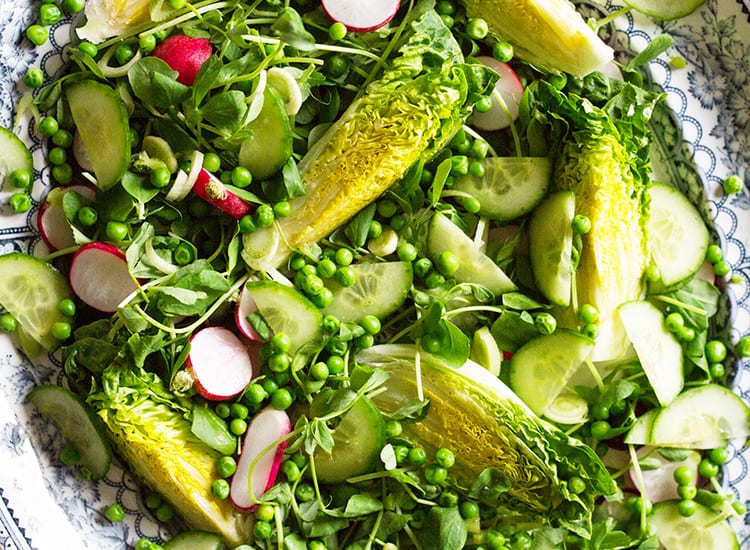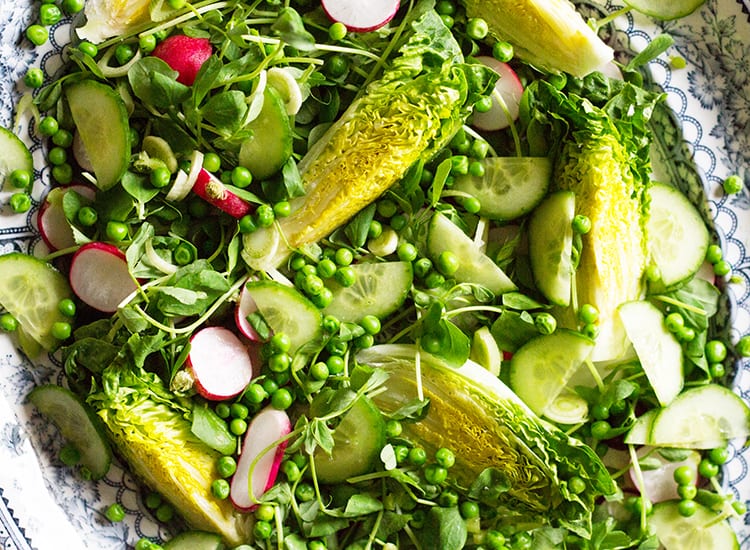Clean 21: 21 Day Detox
Our Signature 21-Day Full-Body Reset
Questions? Ask about this product
Free Shipping On Orders Over $50
Complementary products


Now that the weather is warming up, it’s the perfect time to enjoy big leafy green salads for lunch or dinner. The raw veggies are cooling and hydrating on hot days, especially when you’ve been in the sun or working out a lot. Salads can help cleanse, alkalize and reduce inflammation in the body. Creating the perfect salad is all about the variety and balance of ingredients that you choose.
When we consume salads regularly, we get the benefit of additional enzymes, fiber, macronutrients (a balance of beneficial fats, high-quality protein, and low-glycemic carbohydrates), and micronutrients (vitamins, minerals, and antioxidants). Salads don’t have to feel like “eating rabbit food”; in fact, they can be a very substantial meal that provides satiety and long-lasting energy. Here are our 7 tips:
Dark leafy greens are the base of any perfect salad and feel free to use them liberally as it’s difficult to overdo it with these health-enhancing superfoods. The beauty is that there are so many varieties to choose from: arugula, kale, spinach, lettuce, dandelion greens, and mustard greens. Mix it up, try different types and discover what you like best.
Look in your fridge to see what extra veggies you have lying around that need to be used up. Tomatoes, cucumbers, celery, and radishes all work well-chopped up and tossed into a salad raw. I like to bake a batch of sweet root veggies every week (a mix of beets, carrots, sweet potatoes, turnips, parsnips, and/or squash) to add a dense source of low-glycemic carbohydrates to salads.
Protein creates satiety and stabilizes blood sugar levels, so rotate your choice of salad protein using any of the following:
Animal sources – eggs (if not cleansing), seafood such as grilled salmon, poultry such as grilled chicken breast, and meat such as lamb
Plant sources – whole grains such as quinoa, beans, lentils, chickpeas, tempeh, or hemp seeds
Adding some seasonal fruit like berries are great as they are low in sugar, high in fiber, and packed with antioxidants. This is optional, but a little sweetness can really bring out the freshness in a perfect salad.
Add some raw, sprouted, dry roasted, or lightly toasted nuts and seeds for a little crunchy goodness. Balance this out with something nice and creamy. We like to use a dollop of hummus or some tahini on top of our salads.
No perfect salad is complete without some health-enhancing fats from nutrient-dense whole foods such as wild salmon, eggs, nuts, seeds, coconut flakes, hummus, raw cacao nibs, avocado, olives, and olive oil. Like protein, fat is important for satiety and blood sugar control, plus it adds a ton of flavor. Don’t forget fat comes packed with fat-soluble vitamins including A, D, E, and K.
It’s important to balance the flavors in your perfect salad by making sure your dressing is perfect. We do this by ensuring there is a source of fat (e.g. olive oil), salt (sea salt), acid (e.g. apple cider vinegar or lemon juice), and a little bit of sweet (e.g. coconut nectar). This awesome foursome is sure to delight your taste buds. Just don’t overdo it, a lot goes a long way once you mix it up!
Finding your perfect salad can be a combination you can return to again and again, or one you can change up whenever you feel!
Written by the Clean Team
If you like this article, you might also be interested in What are the best foods for skin health?